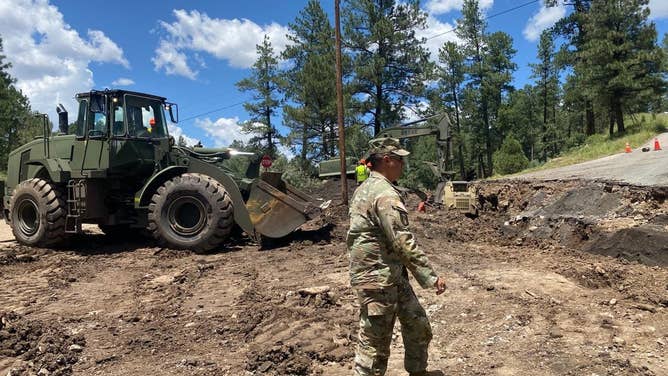Understanding Flash Flood Emergencies: A Comprehensive Guide

Table of Contents
What are Flash Flood Emergencies?
Flash floods are characterized by a rapid, unexpected rise in water levels within a short period, typically less than six hours. This rapid inundation distinguishes them from regular floods, which develop more gradually over days or weeks. The short warning times associated with flash floods make them particularly dangerous, leaving little time for evacuation or protective measures.
Several factors can trigger flash floods:
- Intense Rainfall: Prolonged or exceptionally heavy rainfall, often associated with thunderstorms or hurricanes, overwhelms drainage systems, leading to rapid water accumulation.
- Dam or Levee Failures: Breaches in dams or levees can release massive volumes of water downstream, causing catastrophic flash floods in a matter of minutes.
- Rapid Snowmelt: Sudden and extensive snowmelt, particularly during spring thaws or periods of unusually warm weather, can rapidly increase water levels in rivers and streams.
While precise statistics vary by region, flash floods consistently rank among the deadliest and most costly natural disasters globally, causing significant property damage, injuries, and fatalities.
Recognizing the Warning Signs of Flash Flood Emergencies
Recognizing the signs of an impending flash flood is crucial for timely action. Be vigilant and look for these indicators:
- Visual Signs:
- Rapidly rising water levels in streams, rivers, or normally dry areas.
- Overflowing streams and creeks exceeding their banks.
- Significant changes in water color or turbidity (cloudiness), indicating sediment runoff.
- Audible Signs: The distinctive roar of approaching water, a sound often described as similar to a freight train.
However, visual and audible cues aren't always sufficient. Therefore, relying solely on these is risky. Actively monitoring weather reports is paramount:
- Weather Alerts and Warnings: The National Weather Service (NWS) and local news outlets issue flash flood watches and warnings. Understanding the difference is crucial:
- Flash Flood Watch: Conditions are favorable for flash flooding. Stay informed and be prepared to act.
- Flash Flood Warning: Flash flooding is occurring or is imminent. Take immediate action to protect yourself and your property.
Interpreting these warnings requires prompt action. Don't delay when a warning is issued; act immediately.
Staying Safe During a Flash Flood Emergency
Your actions during a flash flood emergency are critical to your survival.
Immediate Actions:
- Move to Higher Ground Immediately: This is the most important step. Get to elevated areas as quickly and safely as possible.
- Avoid Driving Through Flood Waters: Even seemingly shallow water can hide deep currents, debris, or washed-out roads. "Turn around, don't drown" is a crucial mantra.
- Do Not Walk or Hike in Areas Prone to Flash Flooding: Floodwaters can swiftly rise and trap you unexpectedly.
- Unplug Electrical Appliances: Protect yourself from electrocution by disconnecting appliances near water.
Protecting Your Property:
If you have time before evacuation, take these steps to minimize property damage:
- Move Valuables to Upper Floors: Shift important documents, electronics, and other precious items to higher levels.
- Sandbagging Techniques (If Time Permits): If you have sandbags, use them to protect vulnerable areas of your property.
- Secure Outdoor Furniture and Equipment: Move or secure outdoor furniture, tools, and other items to prevent them from being swept away.
Evacuation Procedures:
- Heed Evacuation Orders Immediately: Evacuation orders are issued for your safety. Do not delay.
- Know Your Designated Evacuation Routes: Familiarize yourself with designated evacuation routes beforehand.
- Have an Emergency Plan and Meeting Point: Establish a family emergency plan, including a designated meeting point outside your home.
- Pack an Emergency Kit: Your kit should include water, non-perishable food, a first-aid kit, medications, flashlights, and other essential supplies.
Post-Flash Flood Emergency Actions
After the immediate danger has passed, several crucial steps must be taken:
- Check for Injuries and Seek Medical Attention if Needed: Prioritize medical assistance for anyone injured.
- Avoid Contact with Floodwater: Floodwater is often contaminated with sewage, chemicals, and other hazardous materials.
- Report Damage to Authorities: Contact local authorities to report damage to your property or infrastructure.
- Document Damage with Photos and Videos: Thoroughly document damage for insurance claims.
- Contact Your Insurance Company: Report your losses to your insurance provider as soon as possible.
- Dispose of Contaminated Materials Safely: Follow guidelines for disposing of flood-damaged materials.
- Clean and Disinfect Affected Areas Thoroughly: Use appropriate cleaning agents to disinfect affected areas.
Preparing for Flash Flood Emergencies
Proactive preparation significantly increases your chances of survival and minimizes damage during a flash flood:
- Develop a Family Emergency Plan: Create a plan detailing evacuation routes, communication strategies, and meeting points.
- Create a Go-Bag with Essential Supplies: Pack a bag with water, food, first aid, medications, and other necessities.
- Identify Safe Evacuation Routes and Meeting Places: Familiarize yourself with several safe routes and meeting locations.
- Monitor Weather Forecasts Regularly: Stay informed about weather conditions and warnings.
- Elevate Valuable Items in Your Home: Store important items on higher shelves or floors to protect them from flooding.
- Consider Flood Insurance: Flood insurance can provide crucial financial protection in the event of a flood.
- Learn About Local Emergency Response Procedures: Understand your local emergency response procedures and contact information.
Conclusion:
Flash flood emergencies are unpredictable and dangerous events. Understanding the risks, recognizing warning signs, and taking proactive steps to prepare are crucial for survival. By following the safety guidelines and developing a comprehensive emergency plan, you can significantly reduce the risks associated with flash flood emergencies and protect your loved ones. Don't wait until it's too late. Learn more about flash flood emergencies today and take steps to protect your family and community. Your preparedness could save lives.

Featured Posts
-
 O Ferstapen Den Einai Pleon Proteraiotita Gia Ti Mercedes
May 25, 2025
O Ferstapen Den Einai Pleon Proteraiotita Gia Ti Mercedes
May 25, 2025 -
 Burys Missing Link Exploring The Lost M62 Relief Road
May 25, 2025
Burys Missing Link Exploring The Lost M62 Relief Road
May 25, 2025 -
 Thunderstorms Trigger Flash Flood Warning In Bradford And Wyoming Counties
May 25, 2025
Thunderstorms Trigger Flash Flood Warning In Bradford And Wyoming Counties
May 25, 2025 -
 Investigating The Use Of A Sixth Century Vessel At Sutton Hoo For Cremation
May 25, 2025
Investigating The Use Of A Sixth Century Vessel At Sutton Hoo For Cremation
May 25, 2025 -
 From Grace To Disaster 17 Celebrities Whose Reputations Imploded
May 25, 2025
From Grace To Disaster 17 Celebrities Whose Reputations Imploded
May 25, 2025
